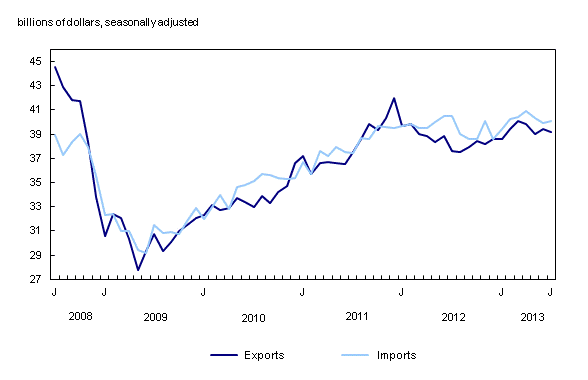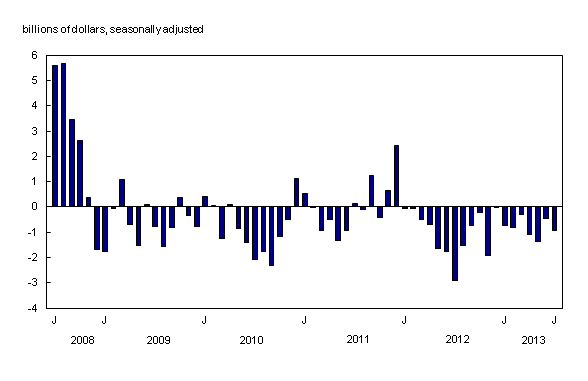Canadian international merchandise trade, July 2013
Archived Content
Information identified as archived is provided for reference, research or recordkeeping purposes. It is not subject to the Government of Canada Web Standards and has not been altered or updated since it was archived. Please "contact us" to request a format other than those available.
Released: 2013-09-04
Canada's merchandise imports grew 0.6% in July while exports declined 0.6%. As a result, Canada's trade deficit with the world widened from $460 million in June to $931 million in July.
Imports grew to $40.1 billion, as volumes were up 1.0% and prices edged down 0.4%. Higher volumes were recorded in metal ores and non-metallic minerals, basic and industrial chemical, plastic and rubber products, and metal and non-metallic mineral products.
Exports declined to $39.2 billion. Lower exports of aircraft as well as unwrought precious metals and precious metal alloys were the main contributors to the decline. Overall, volumes were down 1.7% while prices increased 1.1%.
Imports from the United States rose 2.7% to $26.3 billion, on the strength of imports of lubricants and other petroleum refinery products as well as precious metal ores and concentrates, and precious metal bullion. Exports to the United States were up 0.8% to $29.4 billion. Consequently, Canada's trade surplus with the United States narrowed from $3.6 billion in June to $3.2 billion in July.
Exports to countries other than the United States fell 4.5% to $9.8 billion, as lower exports were reported for the European Union (-15.9%). Imports from countries other than the United States decreased 3.1% to $13.9 billion, with the principal trading area "all other countries" (-3.3%) and the European Union (-5.1%) contributing the most to the decline. As a result, Canada's trade deficit with countries other than the United States was relatively unchanged from June to July at $4.1 billion.
Imports rise on higher volumes
Imports of basic and industrial, chemical, plastic and rubber products increased 12.8% to a record high $3.6 billion in July as volumes rose 15.7%. Lubricants and other petroleum refinery products led the overall gain.
Imports of metal ores and non-metallic minerals grew 38.5% to $1.0 billion, as volumes increased 68.8%. Higher imports of other metal ores and concentrates (+44.6%), mainly precious metal ores and concentrates, and precious metal bullion, were the main contributor to the section's growth.
Imports of metal and non-metallic mineral products rose 7.3% to $3.4 billion, as volumes increased 7.5%. Imports of unwrought precious metals and precious metal alloys led the gain, up 19.9% to $681 million.
Imports of aircraft and other transportation equipment and parts declined 18.1% to $1.1 billion, as imports of aircraft fell in July after posting a large increase in June. Overall, volumes were down 18.3%.
Imports of energy products fell 14.2% to $3.2 billion. Volumes were down 9.6%, and prices 5.2%. Imports of crude oil and crude bitumen (-14.0%) as well as refined petroleum energy products (-30.1%) led the section's decline.
Aircraft and unwrought precious metals and precious metal alloys contribute the most to decline in exports
Exports of aircraft and other transportation equipment and parts fell 22.8% to $1.3 billion in July, as volumes were down 23.0%. Lower exports of aircraft were the main contributor to the section's decline in July, after a large increase in June.
Exports of metal and non-metallic mineral products declined 7.3% to $4.4 billion. The main contributor to this decline was unwrought precious metals and precious metal alloys, down 17.0% on lower volumes (-15.8%).
Exports of forestry products and building and packaging materials rose 8.2% to $2.8 billion. Volumes were up 7.5%. The section's growth in exports was led by pulp and paper stock (+9.6%), as well as lumber and other sawmill and millwork products (+10.0%).
Exports of farm, fishing and intermediate food products grew 10.5% to $2.3 billion in July, following a large decline in June. Wheat (+19.9%) and canola (+39.5%) exports posted the largest gains, on the strength of volumes.
Note to readers
Merchandise trade is one component of Canada's international balance of payments (BOP), which also includes trade in services, investment income, current transfers as well as capital and financial flows.
International merchandise trade data by country are available on both a BOP and a customs basis for the United States, Japan and the United Kingdom. Trade data for all other individual countries are available on a customs basis only. BOP data are derived from customs data by making adjustments for factors such as valuation, coverage, timing and residency. These adjustments are made to conform to the concepts and definitions of the Canadian System of National Accounts.
Data in this release are on a BOP basis, seasonally adjusted and in current dollars. Constant dollars are calculated using the Laspeyres volume formula (2007=100).
For more information on seasonal adjustment, see Seasonal adjustment and identifying economic trends.
Revisions
In general, merchandise trade data are revised on an ongoing basis for each month of the current year. Current year revisions are reflected in both the customs and BOP based data.
The previous year's customs data are revised with the release of the January and February reference months as well as on a quarterly basis. The previous two years of customs based data are revised annually and are released in February with the December reference month.
The previous year's BOP based data are revised with the release of the January, February and March reference months. Revisions to BOP based data for the previous four years were released in June with the April reference month.
Factors influencing revisions include late receipt of import and export documentation, incorrect information on customs forms, replacement of estimates produced for the energy section with actual figures, changes in classification of merchandise based on more current information, and changes to seasonal adjustment factors.
Revised data are available in the appropriate CANSIM tables.
These data are now available in the Canadian International Merchandise Trade Database (Catalogue number65F0013X). From the Browse by key resource module of our website, choose Publications.
The July 2013 issue of Canadian International Merchandise Trade, Vol. 67, no. 7 (Catalogue number65-001-X), is also now available from the Browse by key resource module of our website under Publications.
Data on Canadian international merchandise trade for August will be released on October 8.
Contact information
For more information, contact us (toll-free 1-800-263-1136; infostats@statcan.gc.ca).
To enquire about the concepts, methods or data quality of this release, contact Alec Forbes (613-951-0325), International Trade Division.
- Date modified:



